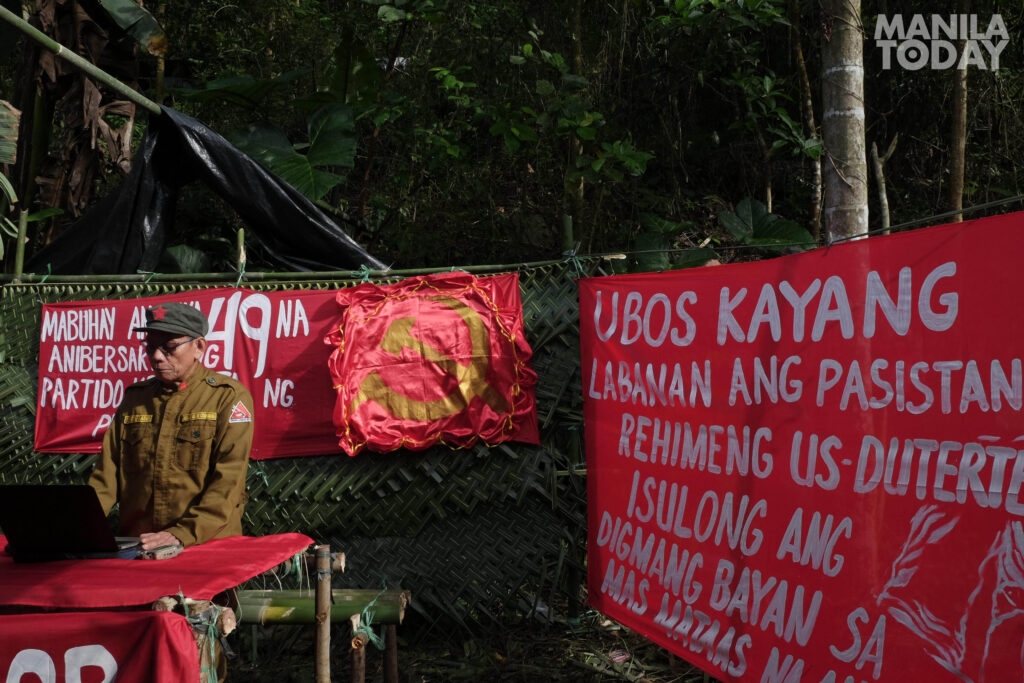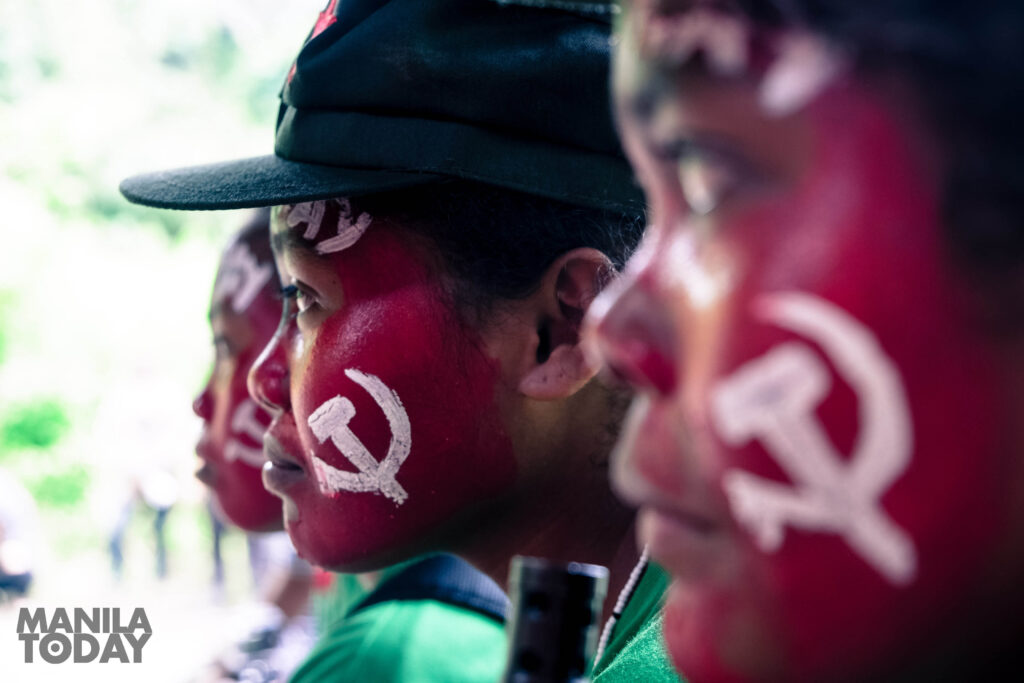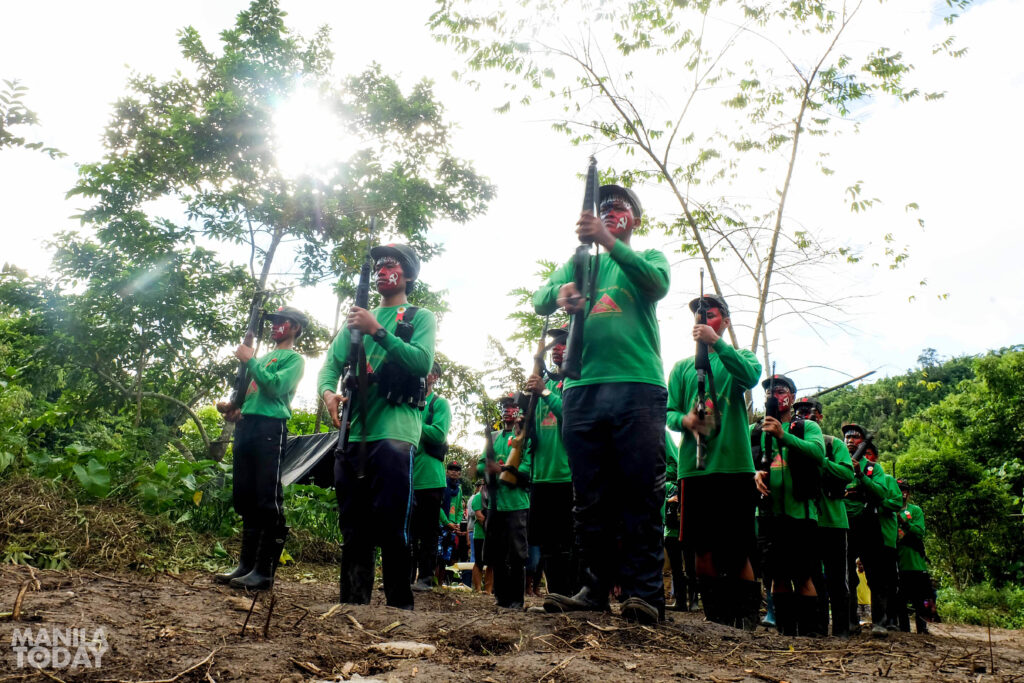
At the break of dawn, somewhere deep within the lush Sierra Mountain range, the steady rhythm of marching boots could be heard amidst the cacophony of chirping birds and crickets. A platoon of young New People’s Army (NPA) guerrillas clad in green chinos march in formation. Their faces were painted with red and blue paint and over that layer of thin mask, inscribed with the words ’49’ on the right cheek, ‘Mabuhay’ [long live] on the forehead and on the right cheek, the ubiquitous crossed hammer and sickle logo that came to stand for communism everywhere in the world since the 100-year old Russian Revolution.
In front of the platoon are two figures symbolizing both the longevity and youthful vigor of the Communist movement.
Jaime “Ka Diego” Padilla, a tall and elderly guerrilla, marches alongside young “Ka Kathryn”, a female red warrior in her mid-twenties, part of the generation that is known today as the millennial. The pseudonyms of revolutionaries are appended with “Ka”, short for “kasama’ [comrade] and that is how they would introduce themselves to the visitors of their anniversary celebration.



They halt as the red flag of the Communist Party of the Philippines (CPP) is gently raised on a bamboo flagpole.
The ceremony marks the start of the celebration of the 49th anniversary of the Communist Party of the Philippines.
Soon after the flag ceremony, a smiling Ka Kathryn guides the journalists to a makeshift tent where the press conference would soon be held.
“Sorry, hindi kami nakapag-print ng statement dahil nagkaroon ng technical difficulty. Hindi namin mapagana ang generator,” explained the soft-spoken Kathryn.
[Sorry we were not able to print the statement because we encountered a technical difficulty. We could not make the generator work.]
There was no other power source because the location was so remote, visitors from other villages had to trek for days just to reach the venue. Due to incessant rain days prior, knee-deep mud further complicated the hike for visitors from the city unaccustomed to the rugged terrain.
Inside the tent, flags and red banners were on display. One banner carried the theme of this year’s celebration: “Ubos kayang labanan ang rehimeng US-Duterte! Isulong ang Digmang Bayan sa mas Mataas na Antas!”
[Resolutely fight the US-Duterte Regime! Advance the People’s War to a higher level)” is painted on the banner.]
Ka Diego Padilla, the spokesperson of the CPP-NPA’s Melito Glor Command in Southern Tagalog region read the prepared written statement on a Macbook Pro.
The statement highlighted the victory and tasks of the revolutionary movement in Southern Tagalog.
According to Padilla, the revolutionary movement welcomed the resumption of peace talks but due to Duterte’s recent statements, the resumption is highly unlikely.
“Bukas tayo na makipagusap sa kanila basta’t seryoso sila sa pakikipagusap,” said Padilla.
[We are open to talks, as long as they are serious about the talks.]
He further explained that the revolutionary movement would never capitulate or give up its arms as long as the roots of poverty are not addressed. Land distribution amongst landless peasants and national industrialization are amongst the top on the list of reforms that could be achieved within the current setup pushed by the revolutionary movement.
“Isang pagtataksil sa bayan kung tayo ay nakipag-coopt sa gobyerno,” said Padilla.
[It would be a betrayal to the people if we would allow ourselves to be coopted by the government.]
With the President’s recent proclamation that the CPP and NPA is a terror group, human rights violations were expected to escalate. In Mindanao alone, according to data gathered by human rights group Karapatan, there has been 29 cases of extrajudicial killings, 15 cases of torture, 23 cases of frustrated killings, 58 victims of illegal arrest and detention and 335,686 victims of indiscriminate gunfire and aerial bombings.
Padilla remained confident that the CPP would overcome the challenges posed by open fascist rule. He explained that the resilience of the CPP comes from the support it enjoys from the masses.
“Lahat ng nagpalit-palit na rehimen ay itinuring tayong terorista. Pero sa kabila nito, naroroon ang suporta ng sambayanang Pilipino,” added Padilla.
[All the previous regimes treated us as terrorists. Despite this, we enjoy the support of the Filipino people.]
Padilla explained the CPP and the NPA’s strict adherence to rules of war and international humanitarian law—without it, people would not join the revolution and believe that it is just. On top of international laws, the NPA also have their own rules inspired from the Chinese Communist Party’s People’s Liberation Army’s rules that include never to take anything from the masses and never to hurt the masses. He said it is the Armed Forces of the Philippines (AFP) and the government are the ones carrying out terroristic and fascist activities. And governments turn to fascism usually when the people’s resistance grow and their rule is threatened.
Diego Padilla is a living testament of the resilience of the revolutionary movement. He was once a young activist in the province Batangas, but the declaration of Martial Law in 1972 prompted him to go underground and take up arms.
On December 5, 2017, President Rodrigo Duterte signed a proclamation declaring the CPP and its armed wing, the NPA as terrorist organizations. This marked a significant shift in relations between the revolutionary movement and Duterte.
The CPP spokesperson belittled modern military equipment boasted by Duterte. In a previous speech, the President threatened to use attack choppers on the red army for target practice. The NPA is keenly aware of hi-tech equipment such as drones to be utilized against them.
“Tao ang mahalaga sa digmaan,” explained Padilla.
[The people is what is important in war.]
He further added that no amount of high tech weaponry would ever defeat the NPA, which is cherished by the peasant masses.
The elderly spokesperson believes in the superiority of guerrilla warfare. He explained that guerrillas are difficult targets because they are constantly mobile.


Duterte, like the former dictator Ferdinand Marcos, intends to crush the communists. But Padilla merely scoffed at Duterte’s statement.
“Sa Mindanao nga, sa halip na humina ang rebolusyonaryong kilusan, higit pa itong lumalakas. Dumarami pa ang sumasampa sa hukbo sa kabila ng matinding atake,” said the senior cadre.
[In Mindanao, instead of weakening the revolutionary movement, it grew stronger. More join the red army despite intensified attacks.]
As mayor of Davao for three consecutive decades, Duterte was friendly to the CPP and NPA, having facilitated the release of numerous prisoners-of-war held captive by the red army. The former mayor even acknowledged historical injustice committed on the people and once told businessmen in Davao to pay revolutionary taxes. In 2015, Duterte allowed the funeral march to honor the legendary NPA commander Ka Parago to take place in Davao. The event was attended by tens of thousands of supporters coming from different parts of Mindanao. A smaller commemoration march, still in the thousands, was held a year after the death of Ka Parago in Duterte’s Davao City.
During the Presidential elections, candidate Duterte boasted of becoming the first Leftist and socialist President once elected.
After Duterte’s victory in the 2015 Presidential elections, the once harmonious relations slowly turned sour as Duterte reneged on campaign and peace talks promises. The release of all political prisoners never transpired. Peace talks resumed, but it was unilaterally and abruptly cancelled by the hot-tempered Duterte as both sides were about to draft an agreement on social and economic reforms to address the roots of poverty.



Martial law, protested by the revolutionary movement, was also extended in Mindanao for another year, and among its objectives is to end the communist threat. Beyond Ka Diego and other CPP and NPA leaders, even politicians and oppositionists to Martial law mouthed how it is Martial Law that served as the NPA’s greatest recruiter.
According to a statement issued by Ka Joaquin Jacinto of NDFP-Mindanao, the NPA was able to launch almost a thousand tactical offensives in 2017 alone, without a single NPA unit wiped out by the AFP.
The NPA has been waging a protracted people’s war since its inception in 1969. From a small force of 60 red fighters armed with 26 inferior arms in the province of Tarlac, the NPA has grown in strength and size, having established their presence nationwide. It has endured all the brutal military campaigns of suppression under previous regimes after Marcos.
After the press conference, revolutionary martyrs of the Southern Tagalog region were honored in a solemn candle lighting. The 15 NPA guerrillas killed in Batangas last December were amongst those honored.
A short program in commemoration of the 49th anniversary took place after the press conference. Leaders from the clandestine organization of workers, peasants, indigenous people, scientists, cultural workers and youth took turns in sharing speeches of solidarity with the CPP, vowing to support and further advance the revolution.
Revolutionary songs and militant dances were performed in between speeches.
As the program drew to a close, fresh recruits of the NPA were given new uniforms. They all took to the stage and explained to the audience their firm decision in taking up arms.
The recruits vary in age and class origins. Some are sons and daughters of peasants and workers, and some come from the educated youth in urban areas. Another new recruit was proud being a member of the LGBT community. They have one thing in common: all pin their hopes on the revolution for a better future.




























